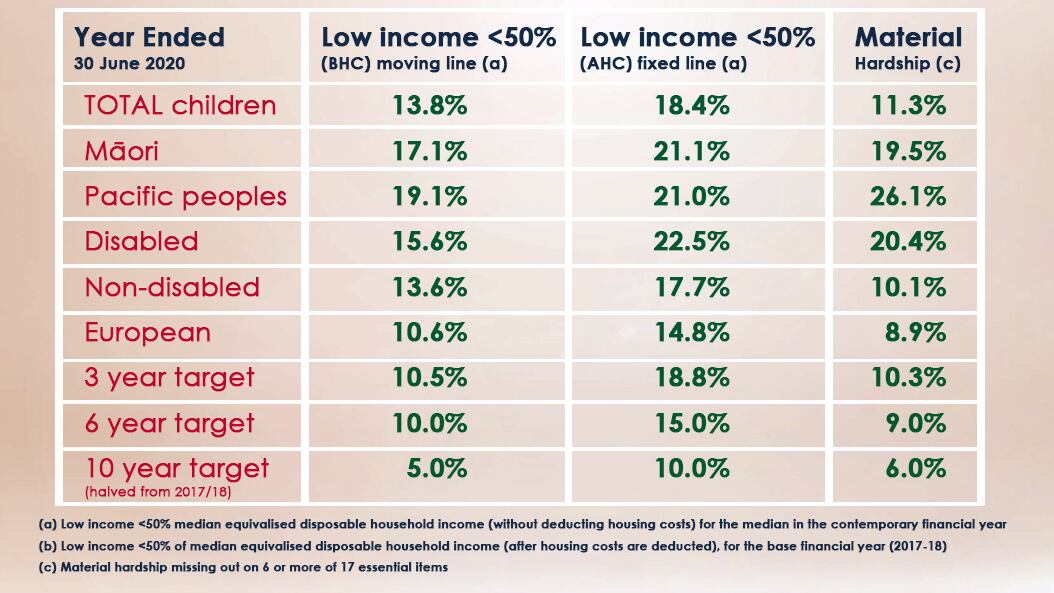Assistant Children's Commissioner Māori Glenis Philip-Barbara says iwi and hapū have constantly demonstrated their ability to successfully create change for their people, and should be allowed to do the same again for child poverty.
The latest Child Poverty Monitor shows poverty targets are mostly on track at a national level and for Pākehā children but much more focused efforts will be needed if they are to be met for Māori, Pacific and disabled children.
It shows that while child poverty at a national level is reducing and is mostly on track to meet government targets, structural barriers such as racism and ableism mean some groups of children are in danger of being left behind.
"There are many challenges ahead but it needs to be clear that all children must grow, with their families for them to achieve their own goals. This is the real purpose for this government and all communities.
"When we're speaking with children, this is what they're saying. From their perspective, poverty is extremely stressful," Philip-Barbara told Te Ao Mārama.
She says whānau should be given the confidence, and ability to achieve their own goals.
"What they want, is to have enough money to pay the bills, and a little to take care of themselves. That's what they want. So how do we tackle this? Give Māori the ability to look after Māori to benefit us all."
'Something dramatic' needed
Otago University’s Dr Mavis Duncanson says the disparities between groups of children are stark and impact every aspect of their lives.
“It is hugely concerning that immunisation rates for all vaccine-preventable diseases have fallen so low for mokopuna Māori. While 88% of all babies at eight months are fully immunised, for pēpi Māori that has dropped to only 77%. We need child and whānau vaccination programmes with ‘one stop for all your whānau shots,’” Duncanson says.
Children’s Commissioner Frances Eivers says. “Most of us want the same thing for the tamariki mokopuna of Aotearoa – that they grow up in a family that has what they need to thrive. We include every child in that vision, but the reality is too many are being excluded.
“On all main measures we track, Māori, Pacific and disabled children are bearing a much greater burden from poverty and hardship. Unless something dramatic changes, poverty rates for these children will not reach the target level. For example, the government is aiming to reduce material hardship to 6 % of children by 2028."
Material hardship is defined as living in a household that can’t afford six or more essentials including having enough to eat, fresh vegetables, and warm clothes.
“Just over 11 % of all children are experiencing material hardship on current data but, for Pacific children, this is just over 25%, and about 20% for both mokopuna Māori and disabled children. This compares with just under 9% for Pākehā children," Eivers says.

“This is not to deny there has been progress. After decades of tolerating high rates of child poverty, Aotearoa now has strong foundations for making progress for children. Benefit and wage increases are making a difference, the school lunch programme is reaching more than 200,000 children, and it is fantastic that progress is being made on meeting some of the targets in the Child Poverty Reduction Act."
JR McKenzie Trust CE Robyn Scott urges New Zealand to be ambitious for all children.
“Government targets are necessary to keep us on track, but we all have a role to play. Businesses need to ensure they are paying people fairly and creating the kind of conditions where parents and caregivers can manage the pressures of work and family,” Ms Scott says.
Commissioner Eivers says solutions to tackle these inequities include such measures as raising income and much greater protections for renters as most whānau in poverty do not own their own home.
The main benefits in New Zealand will increase by $20 in April 2020. Philip-Barbara says that will not be enough.
"The cost of food, rent, housing, all of those costs are rising for those of us who are employed. So what impact would that have on a family living in poverty, all of these would be stressful. I encourage them to be strong, the benefit and the Family Tax Credit, these two things should provide some relief."
